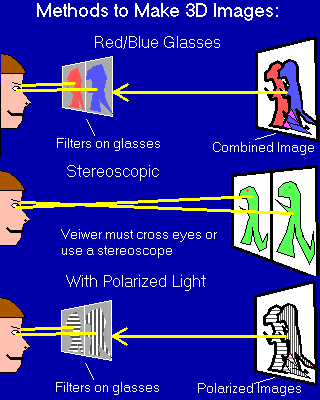Stereoscopic
Vision
 Humans,
along with many animals, have the ability to see three-dimensional
images through the use of stereoscopic (also referred to as
stereographic) vision. Stereoscopic vision involves the use
of both eyes. When you focus on an object each eye has a slightly
different view of it. Your left eye tends to see a little more
of the left side of the object, while your right eye sees a
little more of the right side. Your brain automatically uses
this information, plus the angle your eyes have to turn to focus
on the object, to supply you with an estimate of the distance
of the object.
Humans,
along with many animals, have the ability to see three-dimensional
images through the use of stereoscopic (also referred to as
stereographic) vision. Stereoscopic vision involves the use
of both eyes. When you focus on an object each eye has a slightly
different view of it. Your left eye tends to see a little more
of the left side of the object, while your right eye sees a
little more of the right side. Your brain automatically uses
this information, plus the angle your eyes have to turn to focus
on the object, to supply you with an estimate of the distance
of the object.
Three-dimensional movies and pictures work by
supplying each of your eyes with a different image. This way
two "flat" images can look three-dimensional. At the unmuseum
we use two different methods to show three-dimensional pictures.
The first is red/blue glasses. With this method the images to
be shown to the right and left eyes are either encoded in shades
of blue or red, then combined. Since the colored lens of the
glasses filter out any color but their own, the left eye, which
has a red lens, only sees the red shades and the right eye,
which has the blue lens, sees the blue shades. The brain combines
them to give you the three dimensional images. The disadvantage
with this approach is that only a monochrome images can be seen
this way.
The second method is to get each of the eyes to
focus on different images. With this the images are placed side
by side. The viewer, by crossing his eyes, can interpose one
on top of the other to generate the 3D picture. The advantage
of this method is that the image has full color. The disadvantage
is that it takes some practice to get the necessary coordination
to do it unless you have a device called a stereoscope.
3D films often use a method similar to red/blue.
Instead of separating the images by using color filters, the
films depend on "polarization." Special filters are used to
polarize the light differently from the left and right images.
A polarization filter consists of a transparent sheet on which
tiny lines have been etched. They run like blinds usually from
the top to the bottom of the filter or left to right. Once light
has been polarized it will pass through another filter with
the same polarization orientation, but not one with an opposite
orientation. The viewers are given glasses with one lens polarized
up and down and the other one left to right so that each eye
sees only the proper image. The advantage of this method is
that it allows full color pictures, but requires both special
glasses and projection equipment.
Some advanced computer systems use special glasses
that "blink" to produce a 3D image on the monitor. As the viewer
observes the screen each lens of the glasses he wears alternate
as a shutter to close off light so the viewer can only see out
one side at a time. This blinking action is coordinated with
the computer which puts up the proper left or right image depending
on the setting of the glasses. This way each of the viewers
eyes only see the proper picture. The blinking action takes
place so fast (usually at least 30 times a second) that the
viewer doesn't notice that shutter action, but thinks he is
seeing continuous images through both lenses.
In a "virtual reality" (VR) helmet each eye is
given a small monitor of it's own to watch and the computer
creates the proper left or right images for each. Since the
computer can monitor the position of the helmet it can continuously
change the images seen by the viewer to match his movements.
This can give the viewer the sensation he is moving in a computer
generated world, or reality, hence the name.
Not all animals use three-dimensional vision.
For example, many fish find it more important to be able to
look all around them for predators, than to accurately gage
distance. For that reason their eyes' visual areas do not overlap,
but point to the left or right. For animals like chimps, though,
it is extremely important to be able to figure just how far
you need to jump to catch the vine on the next tree. 3D vision
is a must for all apes.
Stereoscopic vision isn't our only way to detect
the distance of something. The brain can also use the "focal"
distance of an object to estimate position. Like a camera, the
eye must adjust itself to bring something into sharp detail
(hold your finger in front of you about six inches and focus
on it. Notice that objects farther out are blurry) The brain
uses the amount the eye must change to estimate the distance
of an object, too. The focal method isn't as accurate as stereoscopic
vision, though.
 Finally,
the brain can estimate the size and position of objects by knowing
what they are or how big they seem in relation to other objects
of known size. This is what permits us to see a normal two-dimensional
picture as a three-dimensional scene, instead of just a bunch
of colors slashed up onto a flat surface. It also allows us
to understand that the skyscraper in a picture is hundreds of
feet high, even though the photograph itself is only inches
high.
Finally,
the brain can estimate the size and position of objects by knowing
what they are or how big they seem in relation to other objects
of known size. This is what permits us to see a normal two-dimensional
picture as a three-dimensional scene, instead of just a bunch
of colors slashed up onto a flat surface. It also allows us
to understand that the skyscraper in a picture is hundreds of
feet high, even though the photograph itself is only inches
high.
Although all three-dimensional pictures have sometimes
been referred to as "holographic" only images encoded by a laser
are truly holograms. The holographic process (which uses a laser)
allows much more of an object to be seen than the above stereoscopic
processes. Some holograms allow objects to be seen as three-dimensional
even as the viewer shifts his position from left to right as
well as up and down. With stereoscopic images the viewers' position
is locked in.

Copyright Lee Krystek
1997. All Rights Reserved.